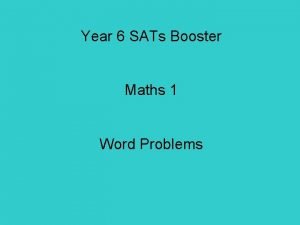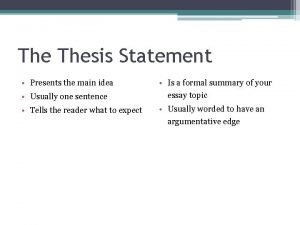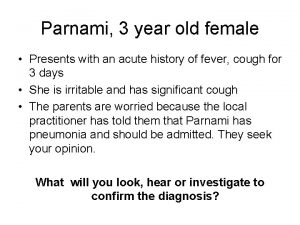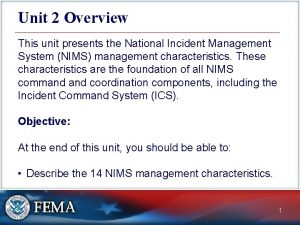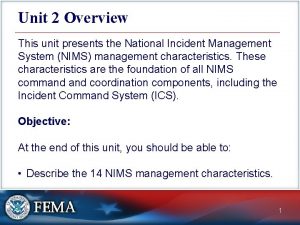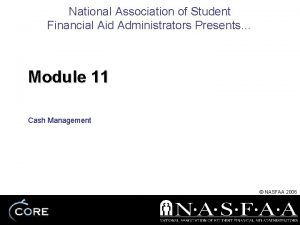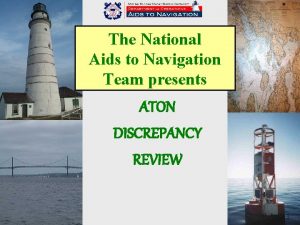Unit 2 Overview This unit presents the National






























- Slides: 30

Unit 2 Overview This unit presents the National Incident Management System (NIMS) management characteristics. These characteristics are the foundation of all NIMS command coordination components, including the Incident Command System (ICS). Objective: At the end of this unit, you should be able to: • Describe the 14 NIMS management characteristics. 1

Making ICS Work Effective incident management relies on a common organizational structure for managing resources, making decisions, and assigning tasks. The Incident Command System (ICS) uses a standardized management approach to ensure that incidents are properly managed and communications are effectively coordinated during an incident. As an incident occurs, you may be called upon to assist -- making you a part of this organizational structure. To ensure success, you should understand how this structure works. 2

NIMS Management Characteristics: Overview 3

NIMS Management Characteristics: Overview - cont The Incident Command System (ICS) is based on the following 14 proven NIMS management characteristics, each of which contributes to the strength and efficiency of the overall system: • Common Terminology • Integrated Communications • Modular Organization • • Management by Objectives Establishment and Transfer of Command • Incident Action Planning • Unified Command • Manageable Span of Control • Chain of Command Unity of Command • Incident Facilities and Locations • Accountability • Comprehensive Resource Management • Dispatch/Deployment • Information and Intelligence Management 4

Common Terminology The Incident Command System (ICS) establishes Common Terminology that allows diverse incident management and support organizations to work together across a wide variety of emergency functions and hazard scenarios. This common terminology covers the following: • Organizational Functions: Major functions and functional units with incident management responsibilities are named and defined. They remain standard and consistent. • Resource Descriptions: Major resources including personnel, equipment, teams, and facilities are given common names and are typed with respect to their capabilities. • Incident Facilities: Common terminology is used to designate the facilities in the vicinity of the incident area. During an incident: • Communications should use common terms. • Organizations should avoid radio codes, agency-specific codes, acronyms, or jargon. Usage of these types of codes may cause confusion or possibly compromise life safety due to a misunderstanding or misinterpretation. The goal is to promote understanding among all parties involved in managing an incident. 5

Common Terminology Discussion Even if you use codes on a daily basis, why should you use common terminology during an incident response? 6

Modular Organization The Incident Command System (ICS) organizational structure develops in a modular fashion based on the incidents size and complexity. • The responsibility for the establishment and expansion of the ICS modular organization rests with the Incident Commander. • As the incident grows more complex, the ICS organization may expand as functional responsibilities are delegated. 7

Management by Objectives The Incident Commander or Unified Command (which will be discussed later), establishes incident objectives that drive incident operations. Management by Objectives includes the following: • Establishing specific, measurable incident objectives. • Identifying strategies, tactics, tasks and activities to achieve the objectives. • Developing and issuing assignments, plans, procedures, and protocols to accomplish identified tasks. • Documenting results for the incident objectives. 8

Incident Action Planning Incident action planning guides effective incident management activities. An Incident Action Plan (IAP) is a concise, coherent means of capturing and communicating overall incident priorities, objectives, strategies, tactics, and assignments in the context of both operational and support activities. The IAP should focus on addressing the needs of future timeframes (called operational periods). To be effective, an IAP should: • Cover a specified timeframe • Be proactive • Specify the incident objectives • State the activities to be completed • Assign responsibilities • Identify needed resources • Specify communication protocols For smaller/less complex incidents, the IAP may be oral or written, except for hazardous materials incidents, which require a written IAP. FEMA has developed a series of ICS Forms for use in developing a written IAP. 9

Incident Action Plan - Activity 2. 1 Activity Purpose: To illustrate how to develop an IAP. Instructions: Working in groups: 1. Identify four items you would include in an Incident Action Plan for the severe weather scenario described below. 2. Record these four IAP items on chart paper. 3. Select a spokesperson to report back to the group. Be prepared to share your answers in 5 minutes. Time: 10 minutes Scenario: Continuing severe weather is causing widespread damage. There are multiple impacts in the community. Vehicle movement is constrained, some people are stranded and are in need of assistance, there have been impacts on communications and power, and some structures are impacted. 9 -1 -1 operators are receiving conflicting reports about a number of life-safety needs, including some weather-related injuries and an unverified report of the structural collapse of an assisted living facility. 10

Manageable Span of Control Depending on your role within the Incident Command System (ICS) structure, you may be asked to manage the activities of others. Span of control refers to the number of individuals or resources that one supervisor can manage effectively during an incident. The optimal span of control is one supervisor to five subordinates (1: 5). However, effective incident management may require ratios significantly different from this. This ratio is a guideline--incident personnel should use their best judgement to determine the appropriate ratio for an incident. 11

Manageable Span of Control Discussion What are some examples of when span of control is most critical? 12

Incident Facilities and Locations Depending upon the incident size and complexity, various types of support facilities may be established by Incident Command. These designated facilities typically include: • Incident Command Post (ICP) • Incident base, staging areas, and camps • Mass casualty triage areas • Point-of-distribution • Emergency shelters 13

Comprehensive Resource Management describes standard mechanisms to identify requirements, order and acquire, mobilize, track and report, demobilize, and reimburse and restock resources such as personnel, teams, facilities, equipment and supplies. 14

Comprehensive Resource Management Discussion Why is Comprehensive Resource Management important during an incident? 15

Integrated Communications Incident communications are facilitated through the development and use of a common communications plan and interoperable communication processes and systems that include voice and data links. Integrated Communications are necessary to: • Maintain connectivity • Achieve situational awareness • Facilitate information sharing 16

Integrated Communications Discussion What are some examples of what Integrated Communications may look like? 17

Establishment and Transfer of Command The command function should be clearly established at the beginning of an incident. The jurisdiction or organization with primary responsibility for the incident designates the Incident Commander and the process for transferring command. Transfer of command may occur during the course of an incident. When command is transferred, the process should include a briefing that captures all essential information for continuing safe and effective operations. 18

Establishment and Transfer of Command Discussion What are some reasons that Command might be transferred? 19

Unified Command In a Unified Command there is no single "Commander. " Instead the Unified Command manages the incident through jointly approved objectives. Unified Command allows agencies with different legal, geographic, and functional responsibilities to work together effectively without affecting individual agency authority, responsibility, or accountability. Unified Command is typically established when no single jurisdiction, agency or organization has the authority and/or resources to manage the incident on its own. 20

Chain of Command Chain of command is an orderly line that details how authority flows through the hierarchy of the incident management organization. Chain of command: • Allows an Incident Commander to direct and control the actions of all personnel on the incident. • Avoids confusion by requiring that orders flow from supervisors. 21

Unity of Command While chain of command relates to the overall hierarchy of the organization, unity of command deals with the fact that all individuals have a single designated supervisor they report to. Based on the principle of unity of command, you will: • Report to only one Incident Command System (ICS) supervisor. • Receive work assignments only from your ICS supervisor. When you are assigned to an incident, you no longer report directly to your day-to-day supervisor. 22

Accountability Effective accountability during incident operations is essential. As part of the Incident Command System (ICS) structure, you will need to abide by agency policies and guidelines and any applicable local, tribal, state, or Federal rules and regulations. There are several principles you will need to adhere to: • Check-In/Check-Out. All responders must report in to receive an assignment. Checking out is just as critical as checking in. • Incident Action Planning. Response operations must be coordinated as outlined in the Incident Action Plan. • Unity of Command. Each individual will be assigned to only one supervisor. • Personal Responsibility. ICS relies on each individual taking personal accountability for his or her own actions. • Span of Control. Supervisors must be able to adequately supervise and control their subordinates, as well as communicate with and manage all resources under their supervision. • Resource Tracking. Supervisors must record and report resource status changes as they occur. Accountability starts as soon as a resource is requested through the time that the resource returns to their home base safely. 23

Dispatch/Deployment Resources should be deployed only when requested or when dispatched by an appropriate authority through established resource management systems. Resources not requested should refrain from selfdispatching to avoid overburdening the incident command. 24

Dispatch/Deployment - Activity 2. 2 Instructions: Working individually: • Review the scenario and discussion question presented in the Student Manual. • Be prepared to share your answer in 5 minutes. Time: 10 minutes Scenario: Rosa is an off-duty certified Emergency Medical Technician who lives near the scene of a major structural collapse that has occurred in a busy shopping center. The media are reporting that there are injured people wandering around the parking area who need immediate medical attention. What should Rosa do? 25

Dispatch/Deployment Discussion Why shouldn't personnel arrive at an incident without being requested or dispatched? 26

Information and Intelligence Management Information and intelligence are important in the Incident Command System (ICS). Incident management must establish a process for gathering, analyzing, assessing, sharing, and managing incident-related information and intelligence. In NIMS, "intelligence" refers exclusively to threat-related information developed by law enforcement, medical surveillance, and other investigative organizations. 27

Information and Intelligence Management Discussion What are some examples of sources where you can find and gather information and intelligence? 28

Unit 2 Summary You have completed the National Incident Management System (NIMS) Management Characteristics unit. This unit introduced: • Common Terminology • Integrated Communications • Modular Organization • • Management by Objectives Establishment and Transfer of Command • Incident Action Planning • Unified Command • Manageable Span of Control • Chain of Command Unity of Command • Incident Facilities and Locations • Accountability • Comprehensive Resource Management • Dispatch/Deployment • Information and Intelligence Management 29

Unit 2 Summary Continued The next unit will provide an overview of the ICS Functional Areas and introduce the roles of the Incident Commander and Command Staff. 30
 Overview on the national tuberculosis elimination program
Overview on the national tuberculosis elimination program It presents cause-effect relationships
It presents cause-effect relationships Presents from my aunts in pakistan poem
Presents from my aunts in pakistan poem Presents from my aunts in pakistan
Presents from my aunts in pakistan Sally elatta presents on business agility
Sally elatta presents on business agility 16 3 darwin presents his case answer key
16 3 darwin presents his case answer key Section 15-3 darwin presents his case answer key
Section 15-3 darwin presents his case answer key Sats booster maths
Sats booster maths A text that presents both side of the topic
A text that presents both side of the topic Zids and zods
Zids and zods Prose writing that presents and explains ideas
Prose writing that presents and explains ideas What is nonfiction prose
What is nonfiction prose Gurmit paid £21 for five presents
Gurmit paid £21 for five presents Where does “snowflake girl” help to deliver presents?
Where does “snowflake girl” help to deliver presents? Si je me tais oh j'apprendrai
Si je me tais oh j'apprendrai Thesis statement and main idea
Thesis statement and main idea A 26 year old female presents
A 26 year old female presents This presents
This presents What is tragedy
What is tragedy What element creates the tone and presents the characters
What element creates the tone and presents the characters The text presents
The text presents Presents simple
Presents simple Macbeth literary elements
Macbeth literary elements Poster is a type of communication
Poster is a type of communication A thesis statement presents
A thesis statement presents Which sentence presents a faulty either/or argument?
Which sentence presents a faulty either/or argument? A 41 year old man presents with slow irregular breathing
A 41 year old man presents with slow irregular breathing Writing an informal email
Writing an informal email Hát kết hợp bộ gõ cơ thể
Hát kết hợp bộ gõ cơ thể Slidetodoc
Slidetodoc Bổ thể
Bổ thể







